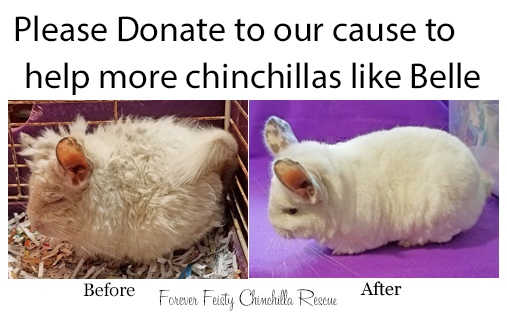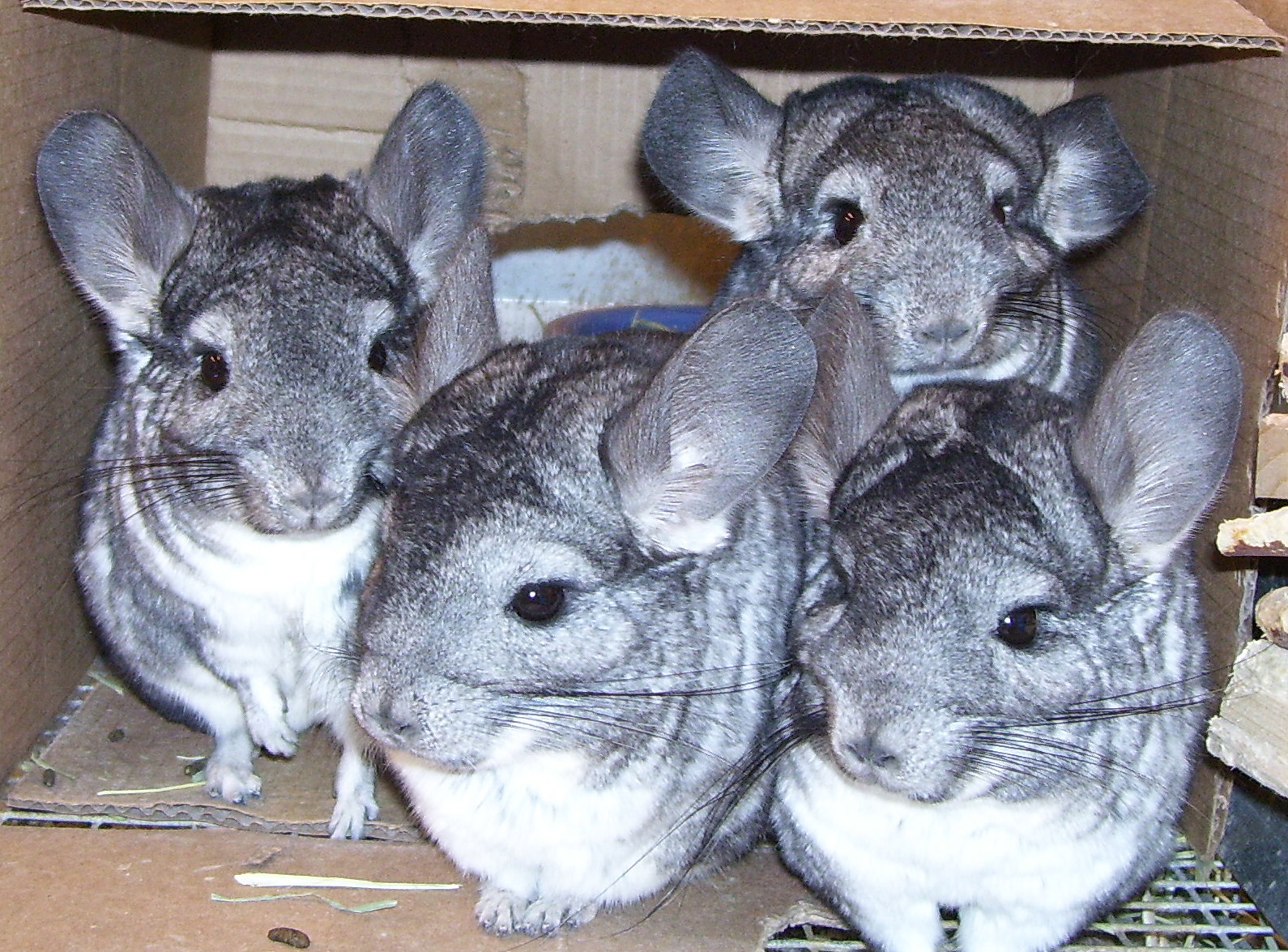The Homeless Crisis
When people learn that I have a chinchilla rescue, the response I often get is surprise because people have no idea there is a need for a chinchilla rescue. I tell them that there is not only a need, but a shortage of places that will take in chins. I am contacted daily from people wanting to surrender their chins. Public shelters are much better about taking chinchillas, but it still does not meet the demand for the number of surrenders. The amount of people wanting to surrender their chins far outnumbers the people wanting to adopt. Why do people want to give up their chinchillas? The most common reason I am given is because they don't have time for them anymore. Allergies, moving, the kids got bored with them and lack of space are the other most common reasons given. Chinchilla rescues across this country are overwhelmed by people giving up their chinchillas.
When I first started my rescue in 2003 I would be asked to take an average of 30 chinchillas a year. That number would grow each year and it accelerated greatly by late 2010. It gives me a heavy heart to say that as of this writing in 2014 I am asked to take about 450 - 500 chinchillas a year! That is just for the Northeast part of the US. That does not include the chins being surrendered to public shelters or other private rescues. It also does not include those chins people wish to surrender, but have no one who can take them because available space is full. Chinchillas in need of a home are a serious problem that can no longer be ignored! The responsibility by breeders and pet stores needs to be addressed and changes need to be made.
The homeless problem is compounded by the fact that many people don't do their research before getting a chin. These animals are often regarded as 'pocket pets'. That title carries with it the implication that these are low maintenance, short lived, toy-like animals for human amusement. Nothing could be further from the truth. Chinchillas are extremely intelligent and share a great range of emotions similar to humans. Many chinchillas are first acquired at pet stores as a spontaneous purchase. They are a cute furball people purchase without knowing anything about the care they require. Unfortunately, most pet stores don't have accurate knowledge of chinchillas and their goal is selling their 'inventory' which is what the animals are considered. Of course the stores also push selling the inappropriate products they carry for chins of which most are not safe or recommended by experienced chin guardians. So the person leaves the pet store with inaccurate information about care, an inappropriate cage, usually low quality food and unhealthy treats. They quickly discover that chinchillas are very hyper, usually don't like to be held and will chew everything, so constant supervision for outside the cage play time is needed. The person is very disillusioned and quickly realizes they are not compatible.
Whatever the reasons people surrender their chins; there are simply not enough appropriate homes for the chins that need one. It is very important that people read and learn before they even consider getting a chinchilla. A chinchilla can have a lifespan of 15 to 20 years and in a few rare cases even longer. As of this writing, I have 19 & 20 year old chins living at my rescue along with many that are 14+ years old. It is very important for you to understand that if you change your mind about keeping your chinchilla and you wish to give them up, you will not easily find a home for him/her. That includes being able to rely on a rescue or shelter to take your chin because often these places are already very full and are unable to help you. It is not a matter of not wanting to help you, but rather it is simply the high demand versus not enough space. Chins are a long time commitment, so please consider this before bringing one into your family.
There is also a big issue with national rescue organizations that do not fully acknowledging the homeless situation with small animals the same as they do with cats and dogs. I know the numbers can't be compared simple because cats and dogs have been animal companions for so much longer, but times have changed and the situation for small animal companions has gotten much worse. Our small critter friends who are homeless and over bred need to be given a spot light and their plight heard. I attended a large homeless animal conference last year in hopes of gathering new information and tips on how to make more of a difference. I wanted to meet like minding people from across the country. The conference promoted itself as being for all animals. I was extremely disappointed to find that nothing about this conference acknowledged the crisis of smaller animals, birds, reptiles or farm animals. When I approached the CEO of the organization about the situation, I was told they would keep it in mind for the future. The chinchillas and others small critters need help now. The more attention that is put on them, the more people will begin to understand how serious this situation has become.
Wild Chinchillas & A Brief History
Chinchillas are from the high altitudes of the Andes Mountains in Peru, Chile, Bolivia and Argentina. Today, there are no chinchillas in many of these areas. They were hunted by the native Chincha Indians for food and their fur. The Chincha's hunted only what they needed to survive. The Chincha were conquered by the Spanish in the 1500's. Chinchilla means 'Little Chincha' in Spanish. Unfortunately, by the 1700's that was the beginning of the slaughter of these unique animals. Once Spanish royalty decided it was a status symbol to wear chinchilla fur, their greed and selfishness brought the chinchillas almost to extinction by 1900. In 1910 the governments of South America prohibited the trapping and hunting of chinchillas.
The 2014 IUCN Red List of Threatened Species has the Chinchillas laniger (long-tailed) and Chinchilla chinchilla; formally known as Chinchilla brevicaudata (short-tailed) listed as Critically Endangered. Even though it is illegal to hunt them, the area which is protected by the Chile government is so large it is extremely difficult to prevent poaching by hunters.
Introducing domestic chinchillas back into the wild has failed. I fully support the efforts to protect wild chinchillas in their natural habitat and truly hope they can reproduce naturally and survive without further interference from man. Domestic chinchillas have been bred and mutated by man beyond their wild ancestors. All wild chinchillas are gray in color to blend in with their natural habitat. It is breeders who have mutated them into multiple colors for the fur and pet industry. That is one of many reasons why I don't support the domestic breeding of chinchillas. It does not benefit nor help the endangered wild chinchillas.
I briefly want to touch upon the beginnings of the chinchilla in the US. Honestly, I don't want to waste a lot of space writing about it because I feel there has been a lot of propaganda of what the reality was, but, I also feel it would be irresponsible to write nothing at all.
A couple of chins were removed from their native country back in 1829 when they were given to the London Zoological Garden and bred successfully. In 1900, the director of the zoo had tried to convince the Chile government to protect the chinchilla, but they did not listen to his request feeling it was not needed at that time. Maybe if they had listened to him, the wild chinchilla would not be in the peril they are today.
For the longest time breeders have sung the praises of Mathias F. Chapman for 'saving' the wild chinchilla. This, in my opinion, is completely false. Mr. Chapman was a wealthy businessman (a mining engineer) who saw the opportunity to make a lot of money when he learned of the demand for chinchilla fur. The only reason he brought them back to the US was to breed them for the fur industry. His motives were not to save the species, but rather to find what was left of the healthiest chins and keep them for himself and breed them to make money.
An article written in 1933 by Popular Science Monthly interviewed Mr. Chapman. He gives details of how he captured the chinchillas and managed to somehow keep them alive, but with a lot of hardships that these poor animals had to suffer. The article states 'The worst part of the long trip lay ahead, the sea voyage. He boarded a steamer from Iquique, Chile, with the little fellows panting for breath. Accustomed to thriving in freezing gales far below zero, they suddenly were catapulted into a summer heat none had ever experienced. For forty days and nights, Chapman kept them in virtual refrigerators – ice-chilled cages curtained with moist canvas. Yet they suffered so that many times during that trip he applied ice packs to their head as various animals passed out in the heat.' "To complicate matters," Chapman commented "when only four days out from California they shed their fur and we had to wrap the whole batch in blankets to keep them from freezing." Mr. Chapman also stated "I finally left South America with eleven animals, and arrived in Los Angeles with a dozen. An expectant mother had given birth to two while on the high seas and we managed to save one of them". A total of 12 chins entered CA in 1923.
In the 1930's people started to purchase chinchillas from Mr. Chapman to start their own breeding ranches. Starting in the 1950's, breeders started to mutate chinchilla colors. It was a few years after that when chinchillas started to gain interests as 'pets' and not just the fur industry. Unfortunately, by that time there were also thousands of chinchilla pelting ranches throughout the US and Canada. There have been countless numbers of chinchillas kept in tiny cages with nothing but food and water, mercilessly and painfully killed by electrocution and neck breaking and then skinned for their fur since that faithful day in 1923.
Breeding
I have never made a secret of the fact that I don't support breeding of domestic chinchillas. It serves no purpose with all those that are homeless and unwanted and needing a home, nor does it help the wild chinchilla as introducing domestic chins back into the wild failed. I do, however, have to face the reality that we have many chin breeders in this country. Some do take in a few rescues as a way to help out despite their breeding business. Most, but not all, are open about doing both tasks. I feel if a person is primarily a breeder and does some rescue on the side, they should give full disclosure and be honest with the public about what they do. I also believe that the golden rule which had existed for many years with breeders was 'you never breed a rescue' has fallen to the wayside with many of the newer breeders. This is not a good thing no matter how you look at it.
I need to say that not all breeders are created morally and ethically equal. I also want to make clear that there are many breeders that sell chins as 'pets' only. Many of the long standing breeders would never consider breeding a rescue no matter how beautiful or healthy they appear. Nor do most long standing breeders ever breed a chin with questionable health such as malocclusion. As much as I do not support breeding, I can acknowledge that there is a certain responsibility taken by many long standing breeders that I do agree with. Most of them will only breed chins that they have a genetic history of for three generations. This give a much higher chance that health issues are not being passed down from one generation to another. That of course does not mean that these breeders produce animals that never get sick or have problems, but it does greatly improve the odds of serious illness not being continued. This is a great difference from BYB (back yard breeders) using pet store chins and rescues with no known history being used for breeding.
So many new breeders, 'hobby' breeders and back yard breeders are just looking for a quick way to make a buck. I see a lot of in breeding and back breeding among chins being conducted by newbie's and this is a major contributing factor to all the health issues these animals have suffered in the last few years. It is weakening this species even more. These breeders are inexperienced and really have no interests in improving how they conduct their practices. This is beyond irresponsible and is cruel to these animals who suffer while going through these very serious health issues. I have rescued so many chins that are small in size, very thin body frame; develop malocclusion, heart murmurs, eye issues, kidney problems and some with digestive problems all because of irresponsible breeders. This all has to do with heredity, nutrition and basic care that are being passed from one weak generation to another. These breeders need to be held accountable. The majority of breeders consider this a business and a way to make income. The animals are considered 'livestock' or 'inventory' and the bare minimum is used. There are a few smaller breeders who really do care about their chins and only have a couple of litters a year and have expanded to using larger cages with chew toys, fleece for their chins and extra shelving all to make them more comfortable. This issue of careless breeding is not just a rescuers grievance. I have spoken with several breeders who are angry with how these animals are being bred by 'newbie's' and the health issues that are developing because of it. There is also bickering among breeders themselves, small and large. When a breeder speaks out against pelting or supports rescues, there has been chastising and shunning by those breeders who do not support these issues.
The ranches and larger breeding facilities keep their chins in small cages, at times stacked several cages high, with just the basics of food, water and dust. These animals are used as baby producers with often one male to six females. The chins are numbered to keep track of them because there are so many and their ears are often tagged with a metal clip that has the number and often a letter on it. Females are in separate cages to prevent fighting and a male is placed in a 'run' which is basically a tube or box that runs along the back of all the female cages. The female cages have a small hole for the male to enter and he is either accepted or rejected by the female. A 'breeding collar' is placed on the females neck which is just large enough to prevent her from getting through the same hole the male entered. This prevents the females from getting to the other females or chasing the male if she rejects him. Once the chins stop serving their usefulness or have undesirable fur/coloring, they are either culled (killed) for their pelts or sold to other breeders or the pet industry.
A rescue was conducted to take 55 chins from a breeder in PA who had fallen ill and left his son to care for the chins. The son severely neglected these poor chinchillas. Some of the animals had not received a dust bath in months and were caked with urine and feces. Their cages had not been cleaned in months and they lived in very harsh temperatures of heat and humidity along with freezing temps in the winter. Many of the chins died in their cages before they could be rescued and many others lost their lives after being rescued because of serious health issues. Many suffered from fungus, other illnesses and were very fearful of humans. This breeder should have been charged with animal cruelty and gone to jail, but the authorities were slow to act (which is typical) and with the lives of all the chins at risk, a few smaller breeders purchased the chins and nursed them back to health. What was so pathetic about this was that because authorities did nothing to help these chins, the breeder would only give them up if he got paid for these sick animals! Many people, including myself, contributed to fund the rescue and health care expenses. All were eventually adopted, but it took months for many to recover from their brutal and inhumane treatment they lived with for many years.
For so many chins being used by breeders both small and large, this is not living, it is only existing and there is a big difference when you live in a very small space, alone (unless with kits for a short time) not knowing if today is the day that you have outlived your usefulness versus being in a home with lots of love and attention and the freedom to run around and play.
There are also breeders who are known for selling their chinchillas to medical facilities for research and medical experimentation. Considering these animals are intelligent, beautiful, spirited and giving, they deserve so much more than what man has bestowed upon them.
Pelting
Many people think we do not raise chinchillas for their fur in this country. There are actually many, many chinchilla breeders who breed and raise chinchillas for the fur industry. Most of them also export the pelts. The US has chinchilla ranches that have anywhere from a few hundred to thousands of chinchilla. They are all across this country including the states of CA, CO, MN, OH, MI and many more. Many countries who breed and pelt chins are Brazil, Argentina, Mexico, Chile, Canada, Japan, China and South Korea.
Films of chinchilla electrocution have been made public over the years. Despite breeders claiming their practices for killing chins is quick and painless; this is not the case at all. Years ago a California rancher was charged with cruelty to animals when it was documented they had electrocuted chins by holding them down and then attaching electrodes to the ear and anal canal or penis. For some insane reason, this is considered a humane way to kill chinchillas today. Electrocution is a torturous and very painful way to die and the animal suffers incredibly. There are times when sending an electrical current through these poor defenseless animals does not always kill them the first try in which case they will go through agonizing pain a second time before death. Electrocution is still practiced by many breeders today along with neck breaking.
It takes between 120 – 200 chinchilla pelts to make ONE fur coat!
Years ago the UK made it illegal to raise chinchillas for their pelts. Let's hope the US follows in their footsteps soon. We would like to remember all those who have endured the imprisonment and hardships suffered on chinchilla ranches and those who have lost their lives to pelting. May this only be a horrible memory in our countries history very soon.
Pet Mills & Warehouses
December 15, 2009 was a very sad day for chinchillas. That is the day that 76 chinchillas (4 died) were seized from US Global Exotics warehouse in Arlington TX. Looking at the larger picture was what shocked animal advocates everywhere and showed how truly pathetic some human beings can be. Approximately 27,000 exotic animals and reptiles were also seized as part of the raid on US Global Exotics that faithful December. The couple that owned this company claimed they treated all animals well and took care of them. They fled the country and have a federal arrest warrant issued for them. Jasen & Vanessa Shaw went back to their native country of New Zealand, for now. It was reported that some 80% of all the animals were sick or dying at the time of the seizure.
It is difficult to even begin to write about all that was so morally and ethically wrong with this situation. Places like this are called pet warehouses or mills. I know you have heard of puppy mills, well this is the equivalent of that only for all species of animals and yes, they exist in the United States. Animals are kept under inhumane conditions without proper medical care, nutrition, housing or basic husbandry. Make no mistake; it is places just like this that many pet stores get their 'inventory' of animals. It was reported that the chinchillas were imported from the Netherlands just a night or two before the seizure and were still in their shipping crates. It begs the question, why with so many (actually too many) chinchilla breeders in the US would anyone import them?
More recently 422 chinchillas were purchased from a breeder in CA by the San Diego Humane Society who joined efforts with other SPCA's. They were very fortunate in that a wealthy TV producer funded the seizure of the chinchillas. He donated $50,000 to purchase the chins and another $100,000 to provide supplies and care.
There are many pet warehouses/mills, equivalent to puppy mills that exist in this country. They breed many types of animals including chinchillas, mice, hamsters, guinea pigs, bunnies, ferrets, reptiles, birds, etc. These animals suffer horrible conditions and we need to enact and enforce laws to protect these animals and prosecute the abusers.
Pet Stores
National chain pet stores support many organizations and fund raising events which is wonderful. However, they continue to contradict these efforts by selling animals (including chinchillas) in their stores every day. Most of the animals that are sold in pet stores are from pet warehouses in addition to local breeders. The conditions these animals have to endure in these warehouses are inhumane and there needs to be better laws to shut them down. Pet stores which hold adoption events and have cats and dogs for adoption are great, but does nothing for all the small animals they sell every day. Why is the effort made to help a couple of species of animals, but not all?
As long as pet stores continue to sell animals, whether they are chinchillas or any other animal, they perpetuate the homeless crisis of animals in this country. Any time an animal is purchased from a pet store, it continues the cycle.
I applaud the national chain pet stores that have cat and dog adoptions. I also support the charities that are a separate corporation, but go under the name of the national chain stores. However, I find it shameful that these same stores that have promised not to sell cats and dogs have no issue at all with continuing to sell small animals, birds, reptiles and fish. You can find countless reports on the internet about these stores and the mistreatment, lack of proper care, lack of knowledgeable staff and lack of proper vet care which these animals endure. I personally have spoken with people who quit their jobs at national pet stores because they did not like the treatment the animals were receiving. I myself have witnessed sick animals, habitats that are very overcrowded, dirty animals and animals fighting at well known pet stores.
With the abundance of unwanted and homeless animals in this country, there is no reason for any animal to be sold in a store. Please adopt, don't shop.
Health Issues
I firmly believe that the over breeding and mutation of chinchillas along with back yard breeders has created a multitude of health issues for chins. I have seen the number of different health issues increase greatly over the last decade. The severity of each health issue has also gotten worse. Molocclusion is a prime example of this. In the past, malocclusion would affect a chin between the ages of 4-6 years. If your chin made it past that age, then you could take a sigh of relief that your chin would be ok. That is no longer the case. Chins as young as 1 year and as old as 14 years have been hit with this disease. I believe that many of the poor diets, unhealthy treats, lack of proper chewing and a lower immune system has contributed to the health problems. I also believe that when breeders try to change or mutate chins, they are interfering with what nature intended these animals to be. When you start changing genetics, you weaken the body including the immune system. Man has already taken these animals out of their natural habitat to breed them for profit. Was that not enough? To this day I still read comments by ranchers/breeders which state they are "improving the breed" or are doing "selective breeding". The change in these animals, their new vulnerabilities and the evidence of declining health for so many shows there has been no 'improving the breed'. Chinchillas lived very healthy and happily before the interference and greed of man.






